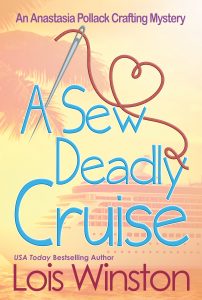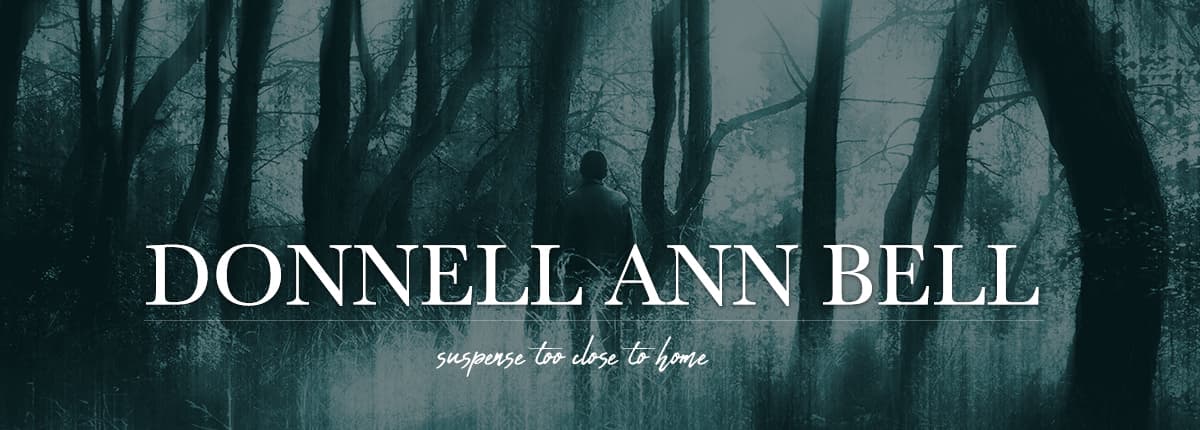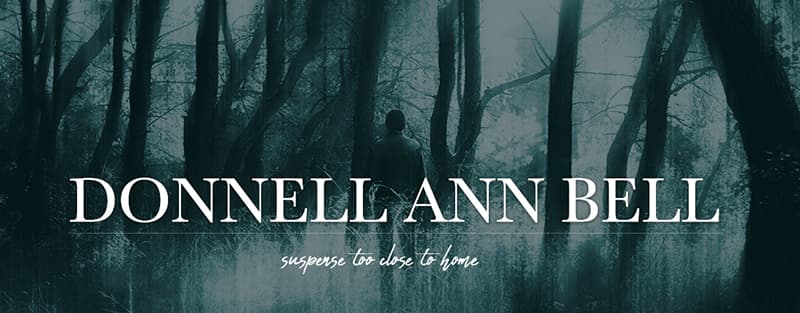Happy 2021, Friends. We’re back with more guest posts on Help From My Friends Friday. I’m particularly happy to host Author Lois Winston again. This woman knows her stuff. For readers, if you have a mystery idea in you, this is a great article. Actually, it’s got a little something for everyone. Enjoy! ~ Donnell
By: Lois Winston

Author Lois Winston
I began my career writing romance. I wrote my first mystery as a result of a conversation my agent had with an editor who was looking for a crafting mystery series. Since my day job consisted of designing craft projects for kit manufacturers, craft book publishers, and both craft and women’s magazines, my agent thought I’d be the perfect person to write such a series. Thus was born my critically acclaimed Anastasia Pollack Crafting Mystery Series.
Crafts and murder don’t normally go hand-in-hand, but normal deserted magazine crafts editor Anastasia Pollack’s world the day her husband permanently cashed in his chips in Las Vegas and her comfortable middle-class life crapped out. Now she’s got her husband’s loan shark demanding payment—or else. And along with debt greater than the GNP of Uzbekistan, she’s permanently stuck with her Communist mother-in-law who is often forced to share a bedroom with Anastasia’s mother, a self-proclaimed descendant of Russian nobility.
Anastasia’s two teenage sons Alex and Nick (not named after Russian czars); her mother’s cat Catherine the Great; her mother-in-law’s dog Manifesto; and Ralph, the Shakespeare-quoting parrot, all vie for space and attention in Anastasia’s cramped suburban New Jersey home.
Did I mention this was a humorous amateur sleuth mystery series?

Throughout the series, Anastasia takes on various moonlighting jobs to pay down her debt, only to find herself constantly tripping over dead bodies, forcing her to continue sleuthing.
The advice I’m offering is based on my experience. There is no elusive Golden Ticket to Success, but there are pitfalls you can avoid if you know what they are.
- Decide on the type of mystery you want to write.
Do you know the difference between cozy mysteries, amateur sleuth mysteries, traditional mysteries, romantic suspense, romantic mysteries, police procedurals, detective stories, and noir mysteries? If not, educate yourself. Different sub-genres have different conventions and different reader expectations.
- Decide whether you want to write a limited series or an ongoing series.
In a limited series the story arc and characters’ goals, motivations, and conflicts develop over a set number of books and are resolved at the end of the last book in the series.
An ongoing series features episodic stories that resolve at the end of each book but include the same main characters throughout the series. Plots are independent of each other but can be tied to previous books. Characters introduced in one book may return several books later. In most cases, the main characters continue to grow throughout the series, sometimes experiencing life-altering changes such as marriage, career change, or death of a family member.
- Develop a character who can carry a series over multiple books.
Set long-term goals for your protagonist and place her in different settings to keep your series fresh. Anastasia’s moonlighting enables me to place her in different locations where she stumbles upon other murder victims. It also gives me the chance to introduce different antagonists, murder victims, weapons, and ways in which Anastasia solves the murders, keeping the stories different enough that readers don’t feel as though I’m recycling plots.
Even though you end each book with the reader learning whodunit, you want to leave your reader wondering what happens next in the character’s life. One way I’ve done this is by introducing new characters. For example, in Revenge of the Crafty Corpse, the third book in the series, I introduced Anastasia’s deceased husband’s previously unknown half-brother.
In Drop Dead Ornaments, the seventh book in the series, I give Anastasia’s older son Alex a girlfriend and create a murder plot that involves her and her father. And of course, there’s the mysterious Zack Barnes, a photojournalist who rented the apartment over Anastasia’s garage in Assault With a Deadly Glue Gun. Even though Anastasia suspects he’s really a government operative, a relationship begins to develop between them as the series progresses.
- Give your protagonist a job conducive to discovering and solving murders.
If you’re writing about a professional investigator, this is a given, but the amateur sleuth needs a career where she isn’t chained to her desk in a cubicle forty hours a week, then goes home to spend her evenings watching TV with only her cat for company. She has to be able to get around to investigate the murders and interact with witnesses and suspects. Having family, friends, neighbors, and coworkers for her to interact with will give you more opportunities for additional plots in future books.
If your sleuth travels for her job, you can locate your plots in different locations, keeping the settings fresh and interesting from book to book. Anastasia has solved murders at the magazine where she’s the crafts editor, at the set of a morning TV show where she was a guest, at a convention center where her company was an exhibitor, and in the town where she lives. The latest book in the series takes place on a cruise ship.
- Create your sleuth’s world.
Decide whether your books will take place in a real town or city, a fictional town or city, or a fictionalized version of a real town or city. I’ve set my books in and around New York City and its New Jersey suburbs. I find it easier to keep track of locations when I’m familiar with them. It’s also fairly simple for me to go to the locations to check them out. Some authors will take a real town or city but change the names. Others will create completely fictional locations.
If you decide on a fictional location, make it a place your readers will want to continue reading about from book to book. Give the place some unique characteristics. Is it a tourist destination? A commuter town near a big city? A college town? A town with only one industry? A shore town or one nestled in the mountains? Your setting should become an integral part of your series.
For fictitious locations create a map to use as a reference while writing your books. You don’t want to make a street one way in one direction in one book and have it going in the other direction two books later. Savvy readers often catch such errors and let you know about them.
If you want to set a story in a real town or city you don’t know or don’t know well, do extensive research regarding the location. Don’t just rely on Google Maps. You don’t want to make the mistake of writing about a massive accident involving half a dozen eighteen-wheelers on a roadway where trucks are forbidden.
- Cupcakes, crafts and cats.
 Three of the most popular sub-genres of cozy mysteries are culinary cozies, crafting cozies, and pet cozies. Culinary and crafting cozies generally include a recipe or craft project. In pet cozies, the pet becomes a secondary character in the series, one the sleuth will often view as almost human. Sometimes the pet will even play a role in solving the mystery.
Three of the most popular sub-genres of cozy mysteries are culinary cozies, crafting cozies, and pet cozies. Culinary and crafting cozies generally include a recipe or craft project. In pet cozies, the pet becomes a secondary character in the series, one the sleuth will often view as almost human. Sometimes the pet will even play a role in solving the mystery.
Even non-pet cozies often feature pets, especially cats and dogs. Editors often insist an author add a cat or dog to the series before offering a contract. In my Anastasia series, Anastasia’s mother owns a cat. Her mother-in-law owns a dog. Both animals mimic their owner’s personalities. Anastasia has inherited Ralph, a Shakespeare-quoting parrot who squawks situation-appropriate passages from The Bard.
When planning your series, you need to decide if you’ll  follow a trend or buck trends, writing something outside the box. In a crowded market it’s often difficult to break in and find a fan base when you’re competing against well-established series. On the other hand, although publishers will always say they’re looking for something new and fresh, they’re often reticent to take a chance on something different from what they know sells. It’s a definite conundrum.
follow a trend or buck trends, writing something outside the box. In a crowded market it’s often difficult to break in and find a fan base when you’re competing against well-established series. On the other hand, although publishers will always say they’re looking for something new and fresh, they’re often reticent to take a chance on something different from what they know sells. It’s a definite conundrum.
When I began writing the Anastasia Pollack Crafting Mysteries, I did some research into crafting mysteries. All either featured a craft shop owner, a crafting club, or a crafter, and all concentrated on a single craft—knitting, crochet, scrapbooking, stained glass, etc. I decided to buck the single-craft trend by making Anastasia the crafts editor at a women’s magazine. That way I could feature a different craft in each book.
- BFFs and sidekicks.
Most cozy and amateur sleuth series will have a sidekick that becomes Watson to your protagonist’s Sherlock. This can be a coworker, a relative, a best friend, or a love interest. The sidekick often provides certain character traits that complement your sleuth. In my Empty Nest Mystery Series, which is a modern-day twist on Nick and Nora Charles of the classic Thin Man movies, my sleuth’s college professor husband is forced to tag along to keep her out of trouble when she insists on sticking her nose into murder investigations. But in Anastasia’s world, depending on the book, her sidekicks alternate between several people in her life, including her best friend, magazine food editor Cloris McWerther, and her tenant-turned-love-interest, Zack Barnes.
- Secondary and tertiary characters.
Juggling the number of characters in your sleuth’s world can be a delicate balancing act. Too few characters won’t give you enough possibilities for plots to keep your series going, but too many can become confusing to the reader.
Not every character you create needs to be in each book. Some characters may play a major role in only one book or pop up sporadically from time to time. Resist the urge to force a character into a story because you introduced him or her in a previous book. Only bring the character back when it makes sense to the story.
When I received a note from a reader wondering if I’d ever bring back Tino Martinelli from Decoupage Can Be Deadly, because she loved the character, I was in the middle of writing Handmade Ho-Ho Homicide. I realized Tino was exactly the character I needed to round out that book’s plot.
- Create a series bible.
If you plan to write a series over many years, it’s essential that you keep accurate track of all series details—descriptions, ages, professions, back-story, relatives, hobbies, street layouts, shops, etc. Don’t rely on memory. Create a database. Each time you add a character, mention a characteristic, or describe a location, add it to the database. Routinely refer to the database to avoid errors.
- Decide how quickly your characters will age.
Most authors write a book a year. Will your characters age a year between each book, or will each book take place days, weeks, or months after the preceding one? This is something you need to decide before you begin writing the second book in your series.
If you choose to have your characters age a year with each book, how will aging affect their world? If your sleuth has teenagers, will they go off to college in future books? Is she nearing retirement age? Will she have to deal with aging parents? What about technological advances and current events? Will you incorporate them into future stories?
- Keep a timeline of events.
It’s far too easy to lose track of the time elapsing in your story as you work on it, especially if you’re a writer who often goes back and tweaks scenes. And you can’t always rely on editors catching every mistake you make. The easiest way to avoid such mistakes is to keep a scene calendar for each book in your series. Print out blank calendar pages. Decide on the month and day your story will start. Record the scenes that occur on each day to keep your timeline accurate.
- Don’t leave readers scratching their heads.
It’s important that each book in your series can be read as a standalone. This is important because most bookstores will not carry many or all of your previous titles in a series unless you become a famous bestselling author. If a reader picks up a book from the middle of your series, you don’t want her to feel confused about the characters in your story. You want her to have an enjoyable reading experience, enough so that she’ll search out your prior titles and purchase future ones.
Avoid the urge to info-dump, though. It’s not necessary to provide each character’s complete biography and description the first time you introduce him or her in each book. A few carefully worded phrases at appropriate times is all you need to avoid reader confusion.
About the Author: USA Today bestselling and award-winning author Lois Winston writes mystery, romance, romantic suspense, chick lit, women’s fiction, children’s chapter books, and nonfiction under her own name and her Emma Carlyle pen name. Kirkus Reviews dubbed her critically acclaimed Anastasia Pollack Crafting Mystery series, “North Jersey’s more mature answer to Stephanie Plum.” In addition, Lois is a former literary agent and an award-winning craft and needlework designer who often draws much of her source material for both her characters and plots from her experiences in the crafts industry.
About the Book: A Sew Deadly Cruise
An Anastasia Pollack Crafting Mystery, Book 9
Life is looking up for magazine crafts editor Anastasia Pollack. Newly engaged, she and photojournalist fiancé Zack Barnes are on a winter cruise with her family, compliments of a Christmas gift from her half-brother-in-law. Son Alex’s girlfriend and her father have also joined them. Shortly after boarding the ship, Anastasia is approached by a man with an unusual interest in her engagement ring. When she tells Zack of her encounter, he suggests the man might be a jewel thief scouting for his next mark. But before Anastasia can point the man out to Zack, the would-be thief approaches him, revealing his true motivation. Long-buried secrets now threaten the well-being of everyone Anastasia holds dear. And that’s before the first dead body turns up.
Craft projects included.
Buy Links
Amazon: https://amzn.to/3fwHR7X
Kobo: https://www.kobo.com/us/en/ebook/a-sew-deadly-cruise
Nook: https://www.barnesandnoble.com/w/a-sew-deadly-cruise-lois-winston/1137427499?ean=2940162697930
Apple iBooks: https://books.apple.com/us/book/a-sew-deadly-cruise/id1526052822
Newsletter sign-up: https://app.mailerlite.com/webforms/landing/z1z1u5
Killer Crafts & Crafty Killers blog: www.anastasiapollack.blogspot.com
Pinterest: www.pinterest.com/anasleuth
Twitter: https://twitter.com/Anasleuth
Goodreads: https://www.goodreads.com/author/show/722763.Lois_Winston
Bookbub: https://www.bookbub.com/authors/lois-winston











Thanks for hosting me today, Donnell. I hope your readers enjoy the post.
Great blog post! I don’t write cozies, but if I did, I would definitely refer to this article. Thank you both, Lois and Donnell. 🙂
So much good stuff here, Lois. Thank you!
Lois, my absolute pleasure!
Francelia, I don’t write cozies. However, there is much to take away from this piece, e.g. is a character necessary to every book because he’s been in book one, two, etc. And how cool, that a character made such an impact that a reader contacted Lois and suggest she bring him back in. Very interactive. And the series bible — so easy to forget over the years…
Vicki, I agree! Thanks for stopping by!
Lois,
You’ve done a great job covering the many aspects of writing a series. The one I always have trouble with, and it’s always easy to screw up if you’re not careful, is remembering to keep a timeline as you write each book. It’s so easy to let Thursday jump to Saturday if you’re not careful!
BTW, I’ve written an article on what to include when writing a cozy series that I publish from time to time.
Thank you Francella and Vicki.
Marilyn, I started keeping a timeline even before I wrote cozies. I was reading a romance by a very famous author years ago. She started the book by stating it was 10 days until the hero’s birthday. At the end of the chapter 3 days had passed, but it was still 10 days before his birthday. No one caught the error before the book went to press. I realized then how important it is to maintain a timeline.
Donnell, I think you should invite Marilyn to post her article on your blog. 😉
Great points, Lois! Love the “bible” idea, or database. Saves the double triple checking of info in a series. Thanks!
Thanks, Francella, Vicki and Nancy!
Marilyn, I started using timelines back when I first began writing after reading a romance by a very famous author. The book opened with it being 10 days before the hero’s birthday. At the end of the chapter 3 days had passed, but it was still 3 days to the hero’s birthday! No one had caught the error before the book went to press.
Donnell, you should invite Marilyn to guest on your blog with her article. 😉
Wonderful post! So informative for anyone thinking about writing a series.
Thanks, Lois and Donnell! Lots of good information here for beginners and experienced authors who want to branch out into cozies.
Thanks, Lynn and Bobbi!
Lots of good info here. Thank you.
Excellent tutorial on how to set up a mystery series. I’m working on a new series and I’ve been working out the kinks in all the things you mentioned. Your research on writing a series shows in your well written and interesting Anastasia books!
I do agree about making each book a stand-alone even if you’re writing a series.
Nice interview!
Thanks, Paty! Good luck with your new series.
Great overview and excellent information for anyone thinking of writing a series. I so wish I had created a “bible” when I started my series. Problem was, I didn’t realize I was going to write a series. Plan ahead.
Maris, what is this phrase you speak of — plan ahead? I agree though, there are times you don’t realize you have a series on your hand. The good news is if the book is well received, it’s easier to go back to book one and create a series bible, etc. Thanks for stopping by.
Another solid article to add to my WRITING BETTER folder. Thanks for sharing this Lois and Donnell for making it avialable.
Ha: Ann, And Lois worried the article was too long. I think writers as well as aspiring authors are craving such in-depth applicable information.
Thanks, Maris and Ann! So glad you found the article useful.
For anyone who doesn’t want the daunting task of going back over earlier books in a series to create a bible, there’s an alternative. If you keep copies of your mss. on your computer, you can easily search through older books using specific key words. For instance, if you can’t remember the color of a character’s eyes, do a search of “eyes” in older mss. that feature that character until you find a passage that gives you your answer. It’s a bit time-consuming, but it does work.
And the real how-to secret, Lois: butt in chair. Year after year after year. Brava!
Excellent overview of how to craft a mystery series. This is the kind of detailed instruction new writers are looking for.
Thanks, Susan!
Great post. Thanks for the wonderful tips.
Thanks, Debbie! Glad you liked it.
Great post, Lois. Thank you. I think it’s time to make that decision about whether this is a limited series or ongoing.